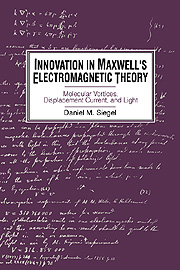Book contents
- Frontmatter
- Contents
- Preface
- Introduction
- 1 The background to Maxwell's electromagnetic theory
- 2 Mechanical image and reality in Maxwell's electromagnetic theory
- 3 The elaboration of the molecular-vortex model
- 4 The introduction of the displacement current
- 5 The origin of the electromagnetic theory of light
- 6 Beyond molecular vortices
- Conclusion
- Appendix 1 Draft of “On Physical Lines of Force,” a fragment
- Appendix 2 Drafts of “A Dynamical Theory of the Electromagnetic Field”
- Appendix 3 Vortex rotations in a curl-free region
- Notes
- Index
Introduction
Published online by Cambridge University Press: 24 October 2009
- Frontmatter
- Contents
- Preface
- Introduction
- 1 The background to Maxwell's electromagnetic theory
- 2 Mechanical image and reality in Maxwell's electromagnetic theory
- 3 The elaboration of the molecular-vortex model
- 4 The introduction of the displacement current
- 5 The origin of the electromagnetic theory of light
- 6 Beyond molecular vortices
- Conclusion
- Appendix 1 Draft of “On Physical Lines of Force,” a fragment
- Appendix 2 Drafts of “A Dynamical Theory of the Electromagnetic Field”
- Appendix 3 Vortex rotations in a curl-free region
- Notes
- Index
Summary
James Clerk Maxwell made momentous contributions to the development of electromagnetic theory: In formulating the set of equations that bear his name, he established a systematic and enduring foundation for modern electromagnetic theory; in developing the formalism to embrace optics, he demonstrated the range and power of his mathematized field theory, adumbrating its profound implications for subsequent developments ranging from relativity theory to communications technology. Maxwell's activity in this area spanned a period of twenty-five years – from the mid-1850s until his death in 1879 – and his thinking on the subject was developing and changing throughout that period. It is possible, nevertheless, to identify one crucial period of innovation: a period of about one year, centering on the summer of 1861, during which Maxwell was working on, and publishing in successive installments, a paper entitled “On Physical Lines of Force.” It was during that period that Maxwell modified one of the fundamental electromagnetic equations through the introduction of a new term called the displacement current, thereby rendering the set of foundational equations complete and consistent; and it was also during that period, in conjunction with the introduction of the displacement current, that Maxwell took the crucial first steps toward the unification of electromagnetism and optics.
- Type
- Chapter
- Information
- Innovation in Maxwell's Electromagnetic TheoryMolecular Vortices, Displacement Current, and Light, pp. 1 - 4Publisher: Cambridge University PressPrint publication year: 1992
- 2
- Cited by



